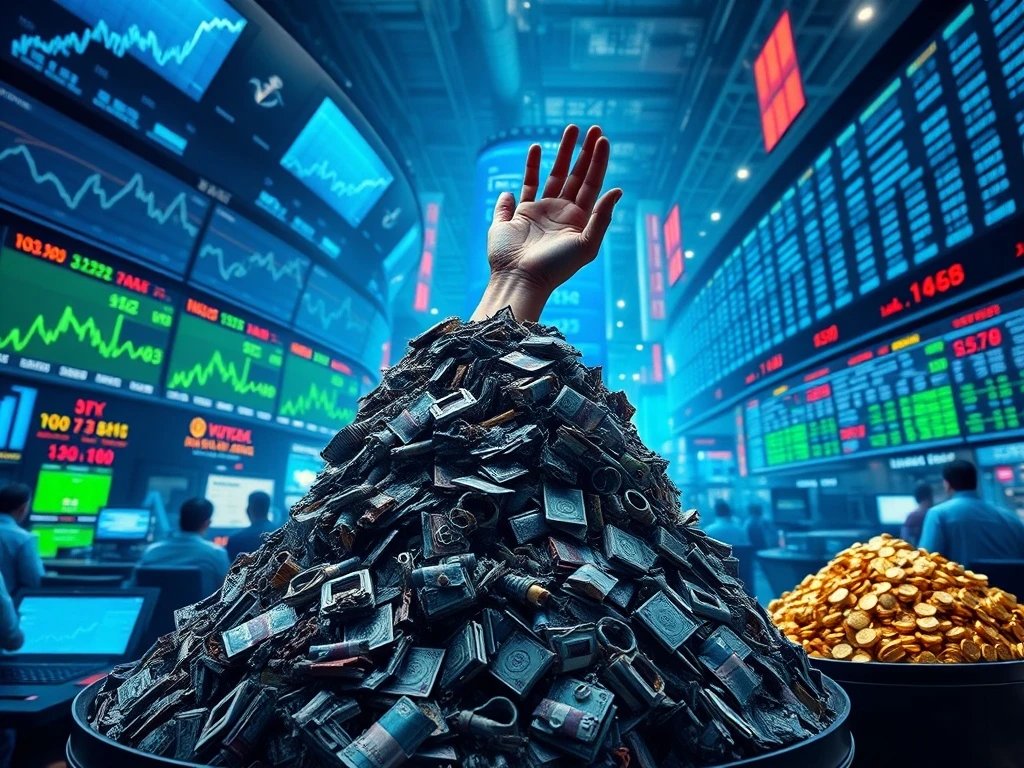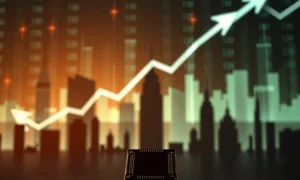Investors constantly seek an edge. They want to understand future market movements. Recently, Goldman Sachs presented a compelling outlook. They suggest a unique phenomenon could emerge. This is the potential for a “Dash for Trash.” This market shift might occur if the U.S. economy continues its robust growth. This concept merits careful consideration for anyone involved in finance or entrepreneurship.
What is the “Dash for Trash” Phenomenon?
The term “Dash for Trash” describes a specific investment trend. It suggests a rapid shift of capital. This capital moves towards riskier, lower-quality assets. These assets often have lower valuations. They are typically considered less desirable during normal market conditions. However, in a strong economic environment, investors might seek higher returns. They then move beyond traditional, safer investments. They start looking for undervalued opportunities.
Historically, investors prioritize stability. They choose blue-chip stocks. They select well-established companies. These firms offer consistent dividends. They also provide steady growth. Yet, a “Dash for Trash” flips this strategy. It favors companies with weaker fundamentals. These might be firms with high debt. They could also be those with unproven business models. The underlying belief is that even these companies will benefit. A booming economy can lift all boats, even the less seaworthy ones.
For instance, during periods of economic expansion, even distressed companies can see a turnaround. Their stock prices may rise significantly. This happens as economic activity increases. Therefore, the “Dash for Trash” is not about reckless investing. Instead, it is a calculated bet. Investors anticipate that the market will reward companies that previously lagged. They see potential for substantial capital appreciation.
Goldman Sachs’ Rationale for a Potential “Dash for Trash”
Goldman Sachs’ prediction stems from several key economic indicators. They analyze the current strength of the U.S. economy. This includes strong employment figures. It also considers robust consumer spending. Furthermore, corporate earnings have shown resilience. These factors create an optimistic economic backdrop.
Moreover, inflation trends play a role. If inflation moderates, it supports economic stability. This reduces the need for aggressive interest rate hikes. Such an environment encourages risk-taking. Investors feel more confident. They are willing to explore less conventional avenues for growth. This directly fuels the “Dash for Trash” narrative.
Goldman Sachs also observes market positioning. Many investors remain cautious. They have favored high-quality, growth-oriented stocks. This has created a valuation gap. Lower-quality assets appear comparatively cheap. As the economy strengthens, this gap might narrow. Capital could flow into these overlooked segments. This would drive up their prices. This scenario presents a compelling case for a “Dash for Trash” strategy.
Key factors contributing to Goldman Sachs’ outlook:
- Strong Economic Growth: Persistent GDP expansion.
- Robust Labor Market: Low unemployment rates, wage growth.
- Resilient Consumer Spending: Driving demand across sectors.
- Moderating Inflation: Easing pressure on interest rates.
- Valuation Discrepancies: Underpriced ‘trash’ assets compared to ‘quality’ assets.
Implications for Investors: Opportunities and Risks
A “Dash for Trash” scenario presents both opportunities and risks. For savvy investors, it could mean significant gains. Identifying undervalued companies early is crucial. These companies might operate in cyclical sectors. They could also be those heavily impacted by economic downturns. As the economy recovers, their fortunes improve. Their stock prices often react sharply.
However, risks are inherent. “Trash” assets are inherently volatile. Their prices can fluctuate widely. This is especially true if economic growth falters. A sudden downturn could lead to sharp losses. Therefore, thorough due diligence is essential. Investors must understand the underlying businesses. They need to assess their financial health. This helps mitigate potential downsides.
Furthermore, timing is critical. Entering the “Dash for Trash” too early can lead to prolonged underperformance. Entering too late means missing out on significant gains. It also risks buying at inflated prices. Market sentiment can shift quickly. Investors must monitor economic data closely. They need to adapt their strategies as conditions evolve. This dynamic environment requires agility.
Identifying Assets in a “Dash for Trash” Environment
In a “Dash for Trash” environment, certain asset classes become more attractive. These often include small-cap stocks. They also encompass value stocks. Companies with high debt loads might also fall into this category. Additionally, cyclical industries could see renewed interest. These sectors perform better during economic expansions.
Consider the following types of assets:
- Small-Cap Stocks: These are smaller companies. They often have higher growth potential. They can also be more volatile.
- Deep Value Stocks: These stocks trade below their intrinsic value. They might have depressed earnings. Yet, they possess strong underlying assets or recovery potential.
- Cyclical Industries: Sectors like manufacturing, materials, and consumer discretionary often benefit. They thrive during economic upturns.
- Distressed Debt: Some investors might even look at the debt of struggling companies. If the economy improves, these companies might recover. This could lead to a significant return on their debt.
The key is to differentiate between truly undervalued assets and fundamentally broken businesses. Not all “trash” is worth picking up. Some companies might have structural issues. These issues are not resolved by a strong economy alone. Therefore, careful selection remains paramount. Investors must apply stringent criteria. They should avoid purely speculative plays.
Navigating the Market: Strategies for Investors
Investors seeking to capitalize on a potential “Dash for Trash” should consider several strategies. Diversification remains crucial. Do not put all capital into risky assets. Instead, allocate a portion of your portfolio. This portion should be dedicated to higher-risk, higher-reward opportunities. Maintain a balanced approach.
Research is indispensable. Conduct in-depth analysis of companies. Look beyond headline numbers. Understand their balance sheets. Examine their cash flow. Evaluate their competitive position. A strong management team is also vital. They can steer the company through challenges. They can also capitalize on opportunities. This detailed approach reduces risk.
Furthermore, consider a phased investment approach. Do not deploy all capital at once. Instead, invest gradually. This allows for dollar-cost averaging. It also provides flexibility. You can adjust your positions as new information emerges. This strategy helps manage market volatility. It also optimizes entry points.
Finally, set clear exit strategies. Determine your profit targets. Also, establish stop-loss limits. This helps protect capital. It prevents emotional decision-making. A disciplined approach is vital in volatile markets. This ensures you lock in gains. It also limits potential losses. The “Dash for Trash” requires a systematic plan.
Expert Opinions and Market Nuances
While Goldman Sachs presents a compelling case for a “Dash for Trash,” other experts offer varying perspectives. Some economists caution against over-optimism. They point to lingering geopolitical risks. They also highlight potential unforeseen economic shocks. These factors could derail even a robust recovery. Therefore, a degree of skepticism is healthy.
Other analysts suggest that market efficiency could limit the extent of a “Dash for Trash.” Information spreads rapidly today. This means mispriced assets are quickly corrected. Therefore, the window for significant gains might be narrow. Retail investors, in particular, might struggle to identify these opportunities early enough. Professional investors with vast resources might have an advantage.
Moreover, the definition of “trash” can vary. What one investor considers undervalued, another might see as fundamentally flawed. This subjective nature adds complexity. It emphasizes the need for independent analysis. Do not rely solely on broad market predictions. Instead, form your own informed opinions.
The bond market also plays a role. If bond yields rise significantly, they could divert capital. Investors might prefer safer fixed-income investments. This would reduce the appetite for riskier equities. Therefore, a holistic view of financial markets is necessary. The “Dash for Trash” is a fascinating theory. Its full realization depends on multiple interacting factors.
Conclusion: The Future of the “Dash for Trash”
Goldman Sachs’ prediction of a potential “Dash for Trash” highlights an intriguing market dynamic. A persistently thriving U.S. economy could indeed lead investors to seek out higher returns. They might look beyond traditional blue-chip stocks. This could result in a significant rotation into undervalued, riskier assets. This shift presents both exciting opportunities and notable challenges for investors.
However, success in such an environment demands prudence. It requires meticulous research. It also calls for disciplined execution. Investors must weigh the potential rewards against the inherent risks. Monitoring economic indicators and market sentiment will be crucial. Only then can they effectively navigate this potential “Dash for Trash.” This strategic insight offers a valuable lens through which to view future market movements.
Frequently Asked Questions (FAQs)
Q1: What exactly does “Dash for Trash” mean in investing?
A “Dash for Trash” refers to a rapid investment trend. Capital shifts towards riskier, often undervalued assets. This happens during periods of strong economic growth. Investors seek higher returns. They move beyond traditionally safe investments. They target assets considered lower quality or out of favor.
Q2: Why does Goldman Sachs predict a “Dash for Trash” now?
Goldman Sachs’ prediction is based on the robust U.S. economy. Key factors include strong employment, consumer spending, and moderating inflation. These conditions create an environment where investors might take more risks. They look for undervalued opportunities in less favored assets.
Q3: What types of assets are considered “trash” in this context?
In a “Dash for Trash” scenario, “trash” assets typically include small-cap stocks, deep value stocks, and companies in cyclical industries. These might also be firms with high debt loads. They are often overlooked or underperforming during normal market conditions. However, they possess recovery potential in a booming economy.
Q4: What are the main risks associated with a “Dash for Trash” strategy?
The primary risks include high volatility and potential for significant losses. “Trash” assets are inherently riskier. If the economic growth falters, these investments can decline sharply. Poor company fundamentals can also lead to permanent capital loss. Thorough due diligence is therefore essential.
Q5: How can investors prepare for a potential “Dash for Trash”?
Investors should conduct extensive research on potential companies. They should also diversify their portfolios. Consider a phased investment approach. Set clear profit targets and stop-loss limits. This disciplined strategy helps manage risks and optimize returns in this volatile market segment.
























